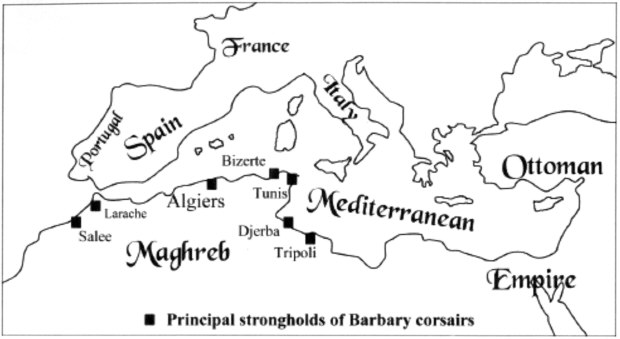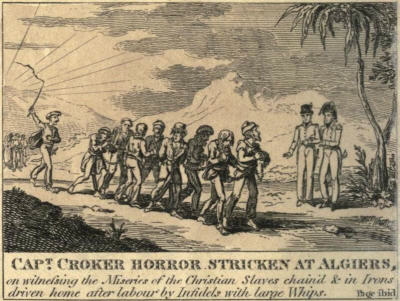European Slaves, African Slave-Masters
A recent British television programme about a sunken galleon in British waters made some brief reference to the Barbary slave trade, something that is very rarely mentioned in these politically correct times. Accordingly, it must be a subject worth exploring further, particularly as many people seem to perceive – understandably in view of continual one-sided propaganda on such issues – that it is only black people who have suffered from slavery at the hands of another race. This perception is one which the global money power is keen to encourage, no doubt, as it inculcates a guilt complex among Whites; which, in turn, tends to stifle objections to the mass importation of cheap labour into the West and the transfer of investment and jobs to the Third World.
A national industry
Historically, the Mediterranean was always plagued by piracy, but from the later Middle Ages the scale of these activities intensified substantially, particularly through the state-supported corsairs operating from the Barbary Coast of North Africa. For several hundred years, they spread terror throughout the waters and coastlines of the Mediterranean and Atlantic. As John Gunther says of the Moors of this period in Inside Africa:–
‘Their national industry was piracy. They lived on loot, human and otherwise, and brought forcibly into the Maghreb great numbers of captured European (Christian) slaves.’ (p. 39)
There were, however, differences between the corsairs’ slave business and the unjustifiably more notorious trans-Atlantic slave trade. The black slaves in the latter trade were sold to white traders by their own people in exchange for rum, brandy, clothes, glass beads and other European goodies; and they were only traded for economic purposes. On the other hand, the white slaves of the North African corsairs were captured in raids on European shipping and coastlines, with no question of purchase or exchange; and they were carried away not just as slave labour, but also for purposes of ransom and harem service.

The Moors in Spain
The Moors were the western-most adherents of Islam, which had spread rapidly in the Middle East and North Africa during the 7th and 8th centuries. They had invaded and occupied Spain in 711. Indeed, they advanced well into France before being defeated at Pointers by Charles Martel in 732. Then they retreated over the Pyrenees, and it was not until 1492, the year Columbus ‘discovered’ America, that they were finally expelled from Spain.
They were heavily engaged in human trafficking, and Andalusia, in Southern Spain, became an important centre for the slave trade. As Stephen Clissold wrote in ‘The Ransom Business,’ (History Today magazine, December 1976):–
‘Cordoba and other cities had their slave-markets where the human merchandise was examined and valued on sophisticated lines. Women were generally more highly prized than men and were carefully assessed by female inspectors, who recorded their physical attractions or defects in the purchase contract. Handbooks listing these good and bad qualities were especially composed to facilitate the delicate task.’ (p. 780)
In passing, it is interesting to reflect that the Moors occupied Spain for nearly 800 years. During much of that time they must have thought: “We are here to stay.”
But they weren’t.
Rise of the Barbary States
The expulsion of the Moors from Spain gave great impetus to the Barbary corsairs. Not only did the expulsion imbue the Moors with a hatred of Christianity, but also their numbers were too great for the economy of their new home, the Maghreb region of North Africa, to absorb. They joined motherland Moors, Algerians, Turks of the Ottoman Empire (to which the Barbary states were often linked) and others in the corsair business of plundering and human trafficking. Clissold tells us that:–
‘The Barbary States were organised primarily for this purpose, and for three centuries they continued to derive the major part of their revenues from the prizes and captives taken, and from the tribute or “presents” with which individual Christian countries sought to purchase immunity.’ (p. 779)
Matters got progressively worse. By the middle of the seventeenth century, the corsairs were marauding in the Atlantic and lurking in the English Channel. Attacks were not confined to merchant vessels. Even fishermen were attacked. Raids were made on coastal settlements, including some on Cornwall, where houses would be looted and inhabitants kidnapped. It is said that at one time 10,000 of the inhabitants of Algiers were slaves, a fifth of them British. Algiers became the chief centre of corsair activity; and the ocean-going vessels it developed were able to operate further away from base than the traditional galleys, bringing even Iceland within reach of the raiders.
Ransom and redemption
Much of the corsairs’ wealth came from the ransoming of captives. Among these, for example, was Cervantes, the famed author of Don Quixote, who was enslaved for five years before his family and friends managed to raise the required ransom money. Ransoming became big business, not only for the corsairs but also for the numerous intermediaries and brokers who negotiated or arranged payment. These included two great Redemptionist religious organisations, the Trinitarians and the Mercedarians, which specifically raised money for the purpose. Governments also sometimes raised ransom for their citizens. Tens of thousands of slaves changed hands in this period.
Ransom money and redemption expenses, often deliberately inflated by unscrupulous intermediaries, were not the totality of the cost. As Clissold relates:–
‘In addition to the ransom money, “presents” had to be made to the ruler and his hierarchy of officials. The number and cost of these had to be worked out and included in the Redemptionists’ budget; or they might otherwise have to buy them on the spot and incur crippling debts. Failure to make presents that their recipients regarded as suited to their rank and expectations caused great offense and might jeopardise the prospects of the mission.’ (p. 783)
Thus, a lot of people besides the corsairs were on the make from the business. As always, corruption breeds corruption.
Collaboration and renegades
The long reign of the corsairs was in no small measure due to the help they received from European governments and individuals. At a time when European solidarity was necessary, we see ruling elites making agreements with the corsairs in order to buy off attacks on their own people and property, or to encourage the corsairs to attack their competitors.
Even more disgraceful was the large-scale defection of renegades to the corsair cause. In those days, as now, there was no shortage of race-traitors willing to make money from the persecution of their own people. Some renegades were captives who had ‘turned Turk’ but many, from all over Europe, made their own way to corsair dominions and voluntarily embraced Islam. They were attracted by the wealth and opportunities in Algiers and other corsair strongholds. Not all of them engaged in piracy; some took positions as personal guards and officials, many reaching the highest positions of authority. Others aided the corsairs in technical matters. Clissold remarks in another article, ‘Christian Renegades and Barbary Corsairs’ (History Today, August 1976):–
‘Renegades and Christian slaves... were the chief agents for the transmission of technology, particularly in the military and naval fields, to the less advanced Islamic lands. It was the renegades who piloted the corsair ships in European coastal waters and divulged the weak spots in the Christian defences.’ (p. 512)
So we see that, as now, the renegades actively assisted in the pillaging of their own lands.

Apostates
The corsairs did not necessarily encourage conversion to Islam. As Clissold writes:–
‘By no means all these renegades had been forced to apostasise against their will. Pressure was indeed often applied against them precisely in a contrary direction. Apostasy did not automatically set a slave free, though he could generally expect to be better treated. He would no longer be fettered and sent to row in a galley. The corsairs, however, needed galley-slaves and were accordingly loath to let their Christians turn Moslem.’ (p. 509)
Other Christians were forced or bribed into changing their religion. Clissold mentions Father Gracian, a Carmelite friar, himself a captive, who related that a fellow priest was offered a substantial dowry if he would turn Moslem and marry the pretty fifteen-year-old daughter of a Moor. Clissold goes on:–
‘Christian girls were in special danger of being forced into apostasy unless they seemed likely to command rich ransoms. Gracian describes coming across a batch of Corsican and Calabrian girls who had just been taken captive. On making enquiries soon afterwards, he learned that all had already apostasised. To resist absorption into the harem was a forlorn hope. We hear of an English girl taken by Sallee Rovers in 1685 who was sent to the Moroccan Emperor Mouley Ismael for the honour of being deflowered. She at first resisted persuasions to turn Moslem and capitulated only after being handed over to the Emperor’s negresses who whipped her and tormented her with needles.’ (p. 510)
Mouley Ismael was truly a very unpleasant and sinister character, but his aims were, perhaps, not so far removed from those of some nasty social engineers of our own time, as we shall see later.
Eclipse
Eventually, several Western countries resorted to military measures against the corsairs. Portugal, Spain, France, Britain and, in 1804, even the United States, all became involved in the bombardment of North African ports in the hope of suppressing piracy. The latter remained remarkably resilient but the number of captives did gradually dwindle, especially after the British Navy’s devastating bombardment of Algiers in 1816. This episode alone Ied to the release of 3,000 slaves, some of whom had been held captive for 35 years. Yet, within two months, the rubble was cleared and the fortifications were rebuilt. It was not until 1830, when the French conquered Algeria, that the piracy was ended.
The multi-racialist Sultan
One can learn some useful lessons from history. For although technology and science might transform our physical environment, it seems unlikely that man himself has changed very much, if at all. The never-ending catalogue of horrific modern atrocities, frauds and other crimes bears testament to that. So it may be well to ponder with concern, as well as with casual interest, the lifestyle and motives of Sultan Mouley Ismael, as recorded in John Gunther’s Inside Africa:–
‘One extraordinary and fiendish choraeter was Sultan Moulay Ismael who ruled for fifty-five years between 1672 and 1727... He set out to build at Meknes, near Fez, a capital that would out-do Versailles. The royal stables alone were three miles long, and contained 12,000 horses; slaves who worked on these and other grandiose projects were, if they did not give satisfaction, cemented into the walls... Moulay is supposed to have had 549 wives, as well as concubines by the thousand, since he seldom used a woman twice. Of his children, 867 survived him. Hundreds of his daughters were strangled at birth. He imported vast numbers of Saharan Negroes to Meknes, systematically mated them to Moorish women, and set about to establish by this means a kind of Praetorian Guard of specially bred half-castes... He had several hundred thousand slaves, of whom 25,000 were captured Christians.’ (pp. 43-44)
Could it possibly be that our own beloved rulers are deliberately promoting miscegenation to create a Praetorian Guard for themselves or the New World Order?
Spearhead magazine, no. 409, March 2003

